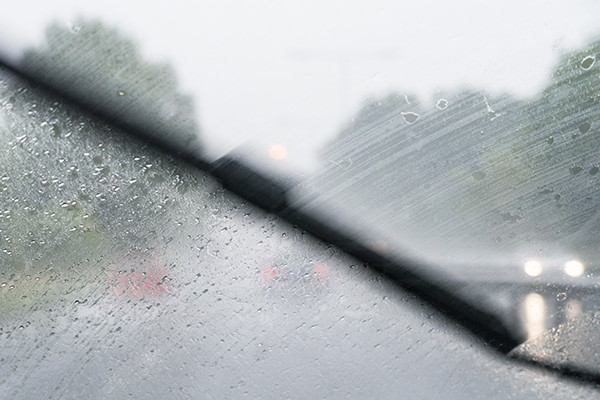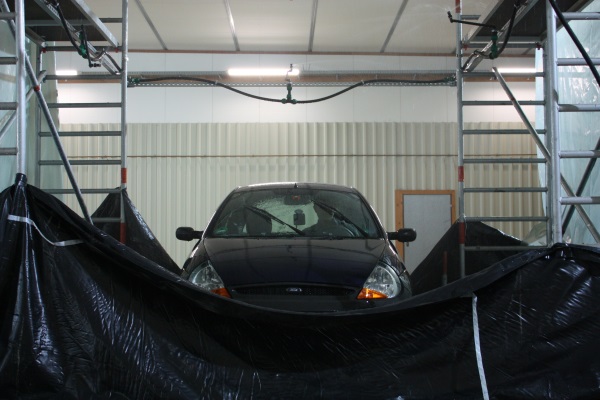
by Julie Freydlin Tuesday, July 22, 2014

Could sensors in cars one day supplant scientific rain gauges? Credit: ©Shutterstock.com/CBCK
Accurate and timely rainfall measurements are crucial for the design of drainage systems, dams and other modern infrastructure. But rain gauges are often spread too sparsely to provide the necessary coverage in densely populated regions. In parts of Germany, for example, gauges equipped to make hourly readings are especially scarce — just one per 1,800 square kilometers. To help fill in the gaps, researchers at the Leibniz University of Hannover are developing an idea they call “RainCars” — using moving cars to measure rainfall.
Ehsan Rabiei and Uwe Haberlandt, who recently described progress on the technology in a study in the journal Hydrology and Earth System Sciences, first tested the idea using a stationary car, which they subjected to “rainfall” from a rain simulator. As the front windshield was covered with water, a person sitting inside the car adjusted the speed of the windshield wipers to maintain visibility from the front windshield. In this way, the speed of the wipers was an indicator of the amount of water collected on the car, lead author Rabiei says. But, with a human controlling the wipers, using the wipers’ speed as a gauge proved inadequate to accurately measure how much rain was falling.

Scientists equipped cars with optical sensors that automatically adjust the speed of the wipers according to the amount of rain accumulated on the sensor, along with a device that recorded data from the sensor to test the idea of RainCars. Credit: Ehsan Rabiei.
So, the team equipped the car with optical sensors that automatically adjusted the speed of the wipers according to the amount of rain accumulated on the sensor, along with a device that recorded data from the sensor. Using the same rainfall simulator, the team found that readings with the optical sensors gave them more accurate rainfall measurements.
Next, Rabiei and Haberlandt considered the speed of moving cars. “If it rains [continuously] over a certain time, moving cars receive more water drops compared to stationary cars, which leads to overestimation of rainfall,” Rabiei says. To adjust for this velocity effect, the researchers tested the optical sensors that were installed on a car-speed simulator, a device shaped like a wind vane. As it spun around, the simulator collected rain drops at a speed comparable to that of a moving car.
As Rabiei points out, laboratory experiments are a far cry from moving cars in the real world, where traffic and other road conditions can muddle the accuracy of rain readings. Still, he says, previous research shows that rainfall estimates based on abundant, albeit less precise, measurements would provide a more accurate portrayal of rainfall over a large area than measurements taken by relatively few sophisticated rain gauges. Furthermore, many modern cars are already made with optical sensors that automatically adjust wiper speed according to rainfall.
Considering that such sensors can provide readings every 10 seconds and that Germany has more than 40 million cars and 75,000 buses on its roads, modern vehicles could provide unprecedented amounts of rain data. Many drivers would likely decline to participate in such studies out of privacy concerns, as their GPS systems would frequently be reporting their location. But buses and taxis might be good options, Rabiei suggests.

Credit: ©Shutterstock.com/Alexander V. Evstafyev.
Not everyone thinks the RainCars idea would solve the issue of scarce rainfall data, however. “It would give us rain information in areas where we already have good coverage from ground-based radars, but not much from rural areas, hills and mountains and underdeveloped areas of the world,” says Robert Adler, a senior research scientist at the Earth System Science Interdisciplinary Center at the University of Maryland at College Park.
Rabiei’s team, however, is continuing to explore the feasibility of RainCars one step at a time. So far, they’ve equipped 12 cars with optical sensors and have sent them out to measure rainfall on the streets. Next, “we need to find [car] companies and people who are willing to cooperate” with us, Rabiei says. In the end, the team hopes the accuracy of rain measurements provided by RainCars would rival the data collected by sophisticated radar systems.
© 2008-2021. All rights reserved. Any copying, redistribution or retransmission of any of the contents of this service without the expressed written permission of the American Geosciences Institute is expressly prohibited. Click here for all copyright requests.